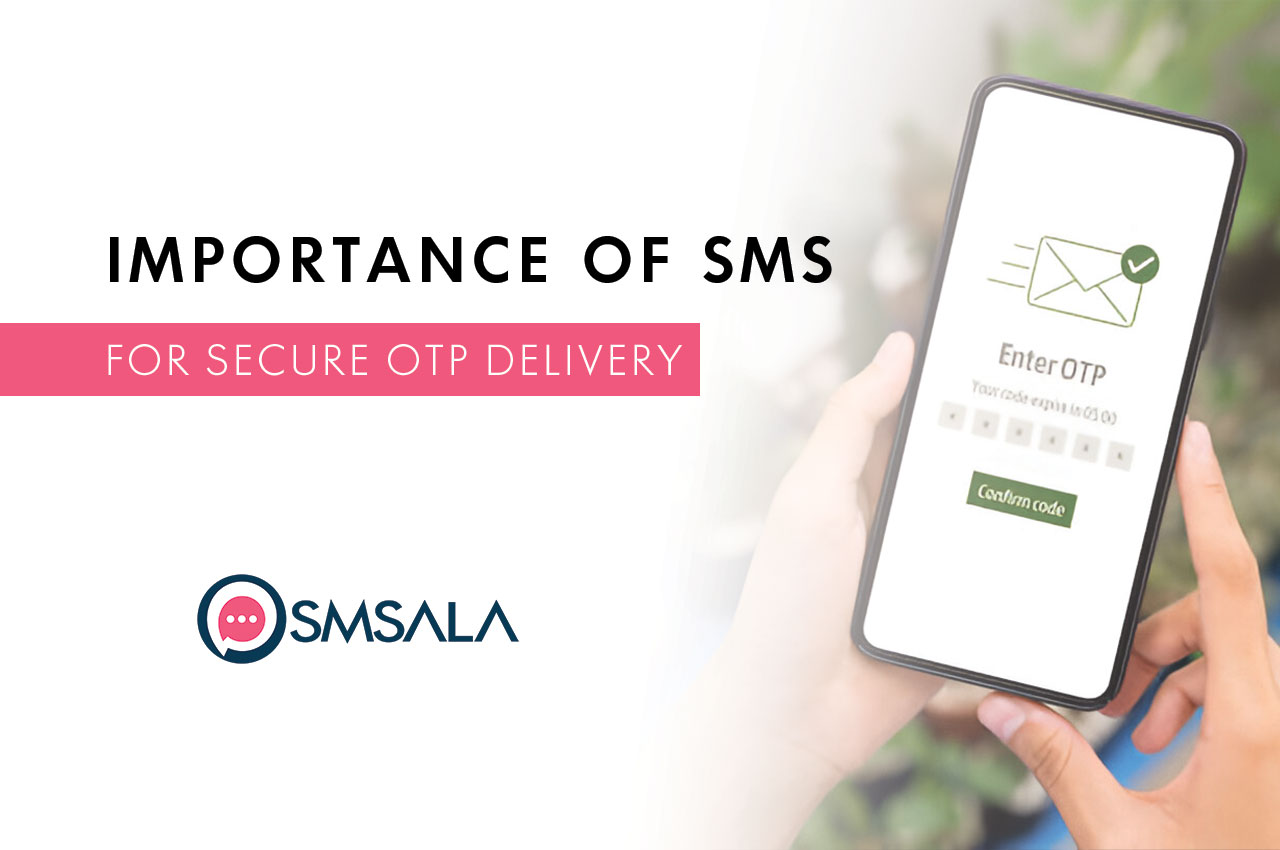In today’s digital landscape, where online transactions, account logins, and sensitive data exchanges are increasingly common, ensuring that user authentication processes are secure is of utmost importance. One of the most widely used methods for securing access and validating identities is through OTP (One-Time Password) delivery. However, not all methods of delivering OTPs offer the same level of security, reliability, and user convenience. Among the various channels, SMS has emerged as the most effective and secure method for delivering OTPs.
But why is SMS so important for secure OTP delivery, and how can businesses ensure that they are using it optimally to protect their customers and their data? This article will explore the role of SMS in secure OTP delivery, its advantages, and how businesses can address challenges and enhance their security measures.
What is OTP and How Does It Work?
Before diving into why SMS is the preferred channel for OTP delivery, let’s first understand what an OTP (One-Time Password) is and how it functions.
What is OTP?
An OTP is a temporary, randomly generated code used for authenticating a user’s identity during online transactions or login attempts. OTPs are commonly used as part of Two-Factor Authentication (2FA) or Multi-Factor Authentication (MFA) processes, which require users to provide two or more verification factors to gain access to an account or service. The OTP is typically valid for a short period, ensuring that even if intercepted, the code becomes useless after its expiry.
How Does OTP Work?
The OTP generation process typically involves the following steps:
- User Initiation: A user attempts to log in to an account or complete a sensitive action (e.g., a financial transaction).
- OTP Generation: The system generates a unique OTP and delivers it to the user through a selected communication channel, such as SMS, email, or app-based authentication.
- User Input: The user receives the OTP and enters it into the designated field on the website or app.
- Verification: The system verifies the OTP, ensuring it matches the one generated. If the OTP is valid, the user gains access or completes the transaction.
Why SMS is the Best Channel for OTP Delivery
There are multiple channels available for delivering OTPs, including email, app notifications, and push-based methods. However, SMS remains the most reliable and secure option for several reasons.
1. Widespread Availability
SMS works on almost all mobile devices, regardless of the operating system or network provider. Unlike app-based OTP methods, SMS does not require users to install additional software or have internet access. This universal compatibility makes it accessible to a wider audience, including users in areas with limited connectivity.
2. Instant and Real-Time Delivery
One of the key strengths of SMS is its instant delivery. The moment an OTP is generated, it is delivered directly to the user’s mobile phone via text message. This speed is essential when dealing with time-sensitive operations like financial transactions, where delays can lead to frustration and even lost sales.
3. High Open Rates
SMS boasts a 98% open rate, which is far higher than email or app notifications. When an OTP is delivered via SMS, there’s a near guarantee that the user will receive and view the message quickly. This immediacy is critical in ensuring secure and efficient user authentication.
4. Fewer Dependency on Apps or Internet
Unlike app-based authentication, SMS does not require an active internet connection or mobile data. This is particularly useful in regions with unreliable internet access, where SMS OTP delivery remains the most dependable option.
5. Improved User Experience
From a user experience perspective, receiving OTPs via SMS is seamless and intuitive. The majority of mobile users are already familiar with receiving and reading text messages, making the process hassle-free.
Security Benefits of Using SMS for OTP Delivery
Given that OTPs are used to secure sensitive actions like account logins and financial transactions, security is paramount. SMS provides several security benefits that make it a highly effective option for OTP delivery.
1. Encrypted Transmission
When SMS is transmitted, it passes through various network providers, and the message is typically encrypted during transit. This reduces the risk of interception by hackers, providing an additional layer of protection for the OTP.
2. Mitigation of Common Attack Vectors
SMS-based OTPs significantly reduce the risk of common cyberattacks such as phishing and brute-force attacks. By using SMS as a second factor in authentication, even if an attacker obtains a user’s login credentials, they would still need access to the user’s mobile device to complete the authentication process.
3. Protection Against SIM Swap and Spoofing
While SIM swapping and SMS spoofing are potential threats to SMS OTP delivery, working with reliable telecom providers and SMS firewalls can significantly mitigate these risks. Firewalls monitor and filter SMS traffic, preventing malicious actors from spoofing numbers or redirecting OTPs to unauthorized devices.
Challenges and Solutions in SMS OTP Delivery
While SMS is a robust and reliable method for OTP delivery, it is not without its challenges. Businesses need to be aware of potential pitfalls and implement strategies to overcome them.
1. Message Delays
In some cases, users may experience delays in receiving OTPs due to network congestion or delivery issues. These delays can negatively impact user experience, especially during critical operations like payment processing.
Solution: Partner with a reliable SMS service provider that guarantees high delivery rates and fast message transmission. Look for providers with a global reach and redundancy systems to ensure that messages are delivered without delays.
2. SIM Swap Attacks
SIM swapping occurs when a malicious actor transfers the victim’s phone number to a new SIM card, allowing them to intercept SMS-based OTPs. This can lead to unauthorized access to accounts and data breaches.
Solution: To mitigate SIM swapping, businesses can implement additional security checks, such as requiring users to verify their identity through a secondary channel or using SMS firewalls that detect suspicious activity and block unauthorized message redirection.
3. International Delivery Challenges
Delivering OTPs to international users can sometimes be problematic due to differences in mobile network infrastructure, message routing, or local regulations.
Solution: Use a global SMS provider with international messaging support. Ensure the provider has a strong network of telecom partners and can navigate regional delivery challenges efficiently.
How SMS Firewalls Ensure Secure OTP Delivery
An essential part of securing OTP delivery is the implementation of SMS firewalls. These firewalls act as a protective barrier, monitoring and filtering incoming and outgoing SMS traffic to detect and block fraudulent activities.
1. Preventing SMS Spoofing and Phishing
SMS firewalls identify and block SMS spoofing attempts, where hackers try to impersonate a legitimate sender to trick users into providing sensitive information. By verifying the authenticity of message senders, firewalls ensure that OTPs are delivered securely to the intended recipient.
2. Blocking SIM Box Fraud
SIM box fraud involves using multiple SIM cards to bypass legitimate messaging routes, leading to revenue loss and delayed message delivery. SMS firewalls detect and block these fraudulent activities, ensuring that OTPs are delivered through legitimate channels.
3. Monitoring Message Integrity
SMS firewalls continuously monitor the integrity of SMS messages, ensuring that no tampering occurs during transit. This guarantees that OTPs remain unaltered and secure throughout the delivery process.
Industry-Specific Use Cases for SMS OTPs
Various industries rely on SMS OTPs for secure authentication and customer verification. Below are some specific use cases where SMS OTPs have become integral to security protocols.
1. Banking and Finance
In the banking sector, SMS OTPs are used for verifying transactions, logging into accounts, and approving payments. Given the sensitive nature of financial data, using SMS OTPs ensures that customers’ accounts remain secure while reducing the risk of fraud.
2. E-commerce
E-commerce platforms use SMS OTPs for account verification, password resets, and validating purchases. By adding an extra layer of security during checkout, e-commerce companies protect their customers from fraudulent transactions.
3. Healthcare
Healthcare providers use SMS OTPs to secure access to patient records, schedule appointments, and verify identity during remote consultations. Ensuring secure access to medical information is critical for maintaining patient privacy and complying with healthcare regulations like HIPAA.
4. Telecommunications
Telecom companies rely on SMS OTPs to authenticate customers during service activation, billing, and account management. Using OTPs in this context reduces the risk of unauthorized changes to customer accounts and ensures the integrity of user data.
Best Practices for Secure OTP Delivery via SMS
To maximize the security and reliability of SMS OTP delivery, businesses should follow a set of best practices. These practices ensure that OTPs are delivered securely, promptly, and consistently.
1. Partner with a Reliable SMS Provider
Choose an SMS provider with a strong reputation for secure and fast message delivery. Ensure the provider has experience handling OTP traffic and offers robust security features like encryption and message tracking.
2. Use Encryption
Encrypt all OTPs during transmission to protect against interception. Even if an OTP is intercepted by a malicious actor, encryption ensures that the data remains unreadable without the correct decryption key.
3. Leverage SMS Firewalls
Implement SMS firewalls to prevent fraud, block spoofing attempts, and monitor message integrity. Firewalls provide an added layer of protection, ensuring that OTPs are securely delivered without compromise.
4. Monitor and Update Security Protocols
Security threats evolve rapidly, so it’s important to continually monitor and update your OTP delivery systems
. Regularly audit security protocols and update encryption standards to stay ahead of emerging threats.
5. Redundancy and Fail-Safe Methods
Combine SMS OTP delivery with backup authentication methods like email OTPs or app-based authentication. This ensures that users receive their OTPs even if there are issues with SMS delivery or network outages.
FAQs About Secure OTP Delivery via SMS
1. What is an OTP and how does it enhance security?
An OTP is a randomly generated, temporary code used to authenticate users. It enhances security by adding a layer of verification beyond just passwords, making it harder for attackers to gain access.
2. Why is SMS the most reliable channel for delivering OTPs?
SMS is widely accessible, works on all mobile devices, and has a high open rate, ensuring OTPs are delivered quickly and reliably.
3. How does encryption work in SMS OTP delivery?
Encryption encodes OTP messages during transmission, ensuring that if the message is intercepted, it remains unreadable without the decryption key.
4. What are the risks of using SMS for OTPs, and how can they be mitigated?
Risks include SIM swapping and message interception. These can be mitigated by using SMS firewalls, monitoring for suspicious activity, and ensuring encryption is used for OTP messages.
5. Can SMS OTP delivery be combined with other authentication methods for added security?
Yes, SMS OTPs can be combined with email OTPs or app-based authentication to provide a multi-layered approach to security.
Conclusion: Ensure Secure and Reliable OTP Delivery with SMS
In a world where cyberattacks and data breaches are growing concerns, SMS OTP delivery offers a secure, reliable, and convenient method for user authentication. By implementing SMS alongside strong encryption, SMS firewalls, and best practices, businesses can ensure the protection of their customers’ sensitive information.
If your business relies on OTPs for secure transactions or user verification, now is the time to invest in a robust SMS delivery system. Partner with trusted SMS providers, prioritize encryption, and follow best practices to safeguard your business and build trust with your customers.




